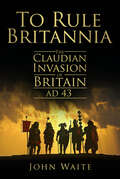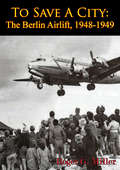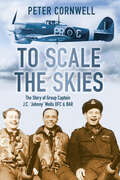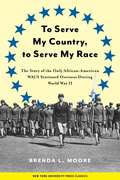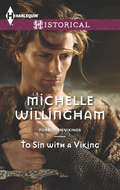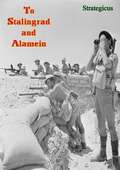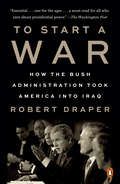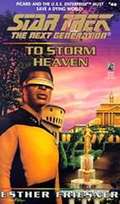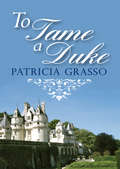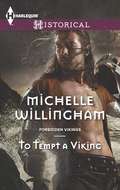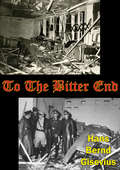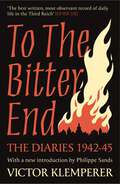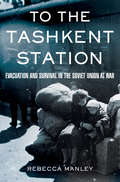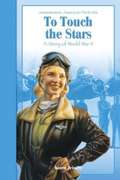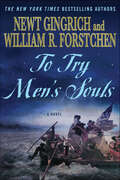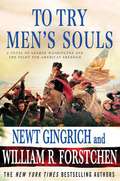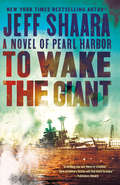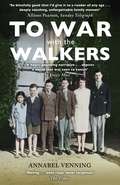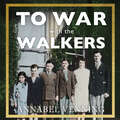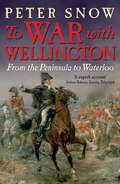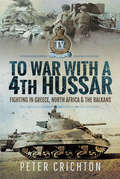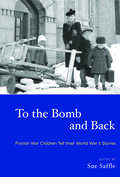- Table View
- List View
To Rule Britannia: The Claudian Invasion of Britain AD 43
by John WaiteIn AD 43, the Romans landed an invasion force on the shores of Britain that heralded the beginnings of recorded British history and laid the cultural foundations of today’s national identity. Yet despite the crucial importance of this event, the actual location of the landings remains unclear. From Victorian antiquarians to today’s modern scholars and archaeologists, there has been much written over the years with regard to this particular question, with Richborough in Kent and Chichester in Sussex proposed as contemporary favourites. Whilst still being universal in its approach, this book is less reliant on archaeology or literary records to support its conclusions, and instead places greater emphasis on the practical problems the Romans faced in deciding on a landing site. The result is a book which presents a straightforward and logical study which can be readily appreciated by both the general reader and the specialist alike.
To Salamaua
by Phillip BradleyFollowing on from his acclaimed book, The Battle for Wau, Phillip Bradley turns his attention to the Salamaua campaign - the first of the New Guinea offensives by the Australian Army in the Second World War. Opening with the pivotal air-sea battle of the Bismarck Sea, this important title recounts the fierce land campaign that was fought for the ridges that guarded the Japanese base at Salamaua. From Mount Tambu to Old Vickers and across the Francisco River, the Australians and their American allies fought a desperate struggle to keep the Imperial Japanese Army diverted from the strategic prize of Lae. To Salamaua covers the entire campaign in one volume for the first time. From the strategic background of the campaign and the heated conflicts, to the mud and blood of the front lines, this is the extraordinary story.
To Save A City: The Berlin Airlift, 1948-1949 [Illustrated Edition]
by Roger G. MillerIncludes 30 IllustrationsIn this expert survey Air Force Historian Robert Miller explores the Epic story of the Berlin Airlift, the confrontation of Democracy and Communism as the world teetered on the brink of the Third World War.The Berlin blockade (24 June 1948;-12 May 1949) was one of the first major international crises of the Cold War. During the multinational occupation of post-World War II Germany, the Soviet Union blocked the Western Allies' railway, road, and canal access to the sectors of Berlin under allied control. The Soviets offered to drop the blockade if the Western Allies withdrew the newly introduced Deutschmark from West Berlin. In response, the Western Allies organised the Berlin airlift to carry supplies to the people in West Berlin. Aircrews from the United States Air Force, the British Royal Air Force, the Royal Canadian Air Force, the Royal Australian Air Force, the Royal New Zealand Air Force, and the South African Air Force flew over 200,000 flights in one year, providing up to 8,893 tons of necessities daily, such as fuel and food, to the Berliners. Neither side wanted a war; the Soviets did not disrupt the airlift.By the spring of 1949 the airlift was clearly succeeding, and by April it was delivering more cargo than had previously been transported into the city by rail. On 11 May 1949, the USSR lifted the blockade of West Berlin. The Berlin Crisis of 1948-1949 served to highlight competing ideological and economic visions for post-war Europe, particularly Germany. The clash ultimately led to the division of that country into East and West and to the division of Berlin itself.
To Scale the Skies: The Story of Group Captain J.C. 'Johnny' Wells DFC and BAR
by Peter CornwellWith humble beginnings as an RAF apprentice, Johnny Wells progressed to pilot and rose to the higher echelons of command at the Air Ministry. From idyllic pre-war training, he would fly bombers against rebels over Iraq, combat Fw190s over England in the newly introduced and equally dangerous Typhoon; he would undertake hazardous low-level anti-shipping strikes in the English Channel, as well as train-busting sorties over occupied territory at night and close-support ground-attack operations across northern Europe following D-Day. Indeed, Wells ended the Second World War as one of the most successful and highly decorated Typhoon Wing Leaders in the Tactical Air Force. This well-researched account of one man's rise through the ranks of the Air Ministry is finely illustrated with contemporary images and is an excellent testimony of what was required of air pilots during the Second World War. Wells' story is both an inspiration and a gripping account of one man's journey through a service career spanning more than three turbulent decades.
To Serve My Country, to Serve My Race: The Story of the Only African-American WACS Stationed Overseas During World War II
by Brenda L. MooreThe story of the historic 6888th, the first United States Women's Army Corps unit of African American women to serve overseasWhile African American men and white women were invited, if belatedly, to serve their country abroad, African American women were excluded for overseas duty throughout most of WWII. However, under political pressure from legislators like Adam Clayton Powell, Jr., the NAACP, the Black press, and even President Roosevelt, the US War Department was forced to deploy African American women to the European theater in 1945.African American women answered the call to serve from all over the country, from every socioeconomic stratum. Stationed in France and England at the end of World War II, the 6888th brought together women like Mary Daniel Williams, a cook in the unit who signed up for the Army to escape the slums of Cleveland and to improve her ninth-grade education, and Margaret Barnes Jones, the unit’s public relations officer, who grew up in a comfortable household with a politically active mother who encouraged her to challenge the system. Despite the social, political, and economic restrictions imposed upon these women in their own country, they were eager to serve, not only out of patriotism but out of a desire to uplift their race and dispel bigoted preconceptions about their abilities. Elaine Bennett, a First Sergeant, joined because "I wanted to prove to myself and maybe to the world that we would give what we had back to the United States as a confirmation that we were full- fledged citizens."Filled with compelling personal stories based on extensive interviews, To Serve My Country, To Serve My Race is the first book to document the lives of these courageous pioneers. It reveals how their Army experience affected them for the rest of their lives and how they, in turn, transformed the US military forever.
To Sin with a Viking
by Michelle WillinghamPLAYING WITH FIRE! Caragh Ó Brannon defended herself bravely when the enemy landed-only, now she finds herself alone with one very angry Viking.... Styr Hardrata sailed to Ireland intending to trade, never expecting to find himself held captive in chains by a beautiful Irish maiden. The fiercely handsome warrior both terrifies and allures Caragh, but he is forbidden territory. He is the enemy...and he is married. Yet Styr harbors a secret that just might set them both free.... Forbidden Vikings Resist them if you can!
To Slay The Dreamer
by Alexander CordellFrom the Spanish sierras to the French Pyrenees, one desperate cause unites them.As the stromclouds gather in the passionate fight against the Fascists, a young Spanish countess and a trained american assassin join forces with the partisans in a desperateattempt on the life of General Franco.TO SLAY THE DREAMER is a rich and compelling story of a group of patriots ready to die for their country - a moving novel of dangerous loyalty amidst the ultimate futility ofwar.
To Stalingrad and Alamein
by StrategicusBeginning with the 1941-1942 Russian winter offensive, this volume of the history of the war by Strategicus carries the story up to the gates of Stalingrad and to the last defences of Egypt. As in previous volumes, this book contains chapters on the strategical and tactical bearing of developments on the sea and in the air."The period covered by the present volume saw major operations for the first time extend to the five continents. When Japan entered the war the German campaign had already died down and although Russia waged a persistent offensive against German positions during the winter it was a matter of what might be called 'task forces'. The mobility of a force during winter, in that period, varied inversely with its weight. Later on, however, Germany resumed her attempt to secure a decision in Russia while the Japanese offensive was still in full swing in the Far East. In May there even seemed to develop a terrible climax. Hitler, in that month, in the Crimea, began his summer offensive, while in North Africa he was again trying to defeat the Eighth Army, and Japan was reducing Corregidor, overrunning the Chinese airfields within raiding distance of Tokyo and fighting the battle of the Coral Sea. Madagascar was invaded by Britain and Russia attacked over a broad front towards the great centre of Kharkov."
To Start a War: How the Bush Administration Took America into Iraq
by Robert DraperFrom the author of the New York Times bestseller Dead Certain comes the definitive, revelatory reckoning with arguably the most consequential decision in the history of American foreign policy--the decision to invade Iraq.Even now, after more than fifteen years, it is hard to see the invasion of Iraq through the cool, considered gaze of history. For too many people, the damage is still too palpable, and still unfolding. <P><P>Most of the major players in that decision are still with us, and few of them are not haunted by it, in one way or another. Perhaps it's that combination, the passage of the years and the still unresolved trauma, that explains why so many protagonists opened up so fully for the first time to Robert Draper.Draper's prodigious reporting has yielded scores of consequential new revelations, from the important to the merely absurd. <P><P>As a whole, the book paints a vivid and indelible picture of a decision-making process that was fatally compromised by a combination of post-9/11 fear and paranoia, rank naïveté, craven groupthink, and a set of actors with idées fixes who gamed the process relentlessly. Everything was believed; nothing was true. <P><P>The intelligence failure was comprehensive. Draper's fair-mindedness and deep understanding of the principal actors suffuse his account, as does a storytelling genius that is close to sorcery. There are no cheap shots here, which makes the ultimate conclusion all the more damning. In the spirit of Barbara Tuchman's The Guns of August and Marc Bloch's Strange Defeat, To Start A War will stand as the definitive account of a collective process that arrived at evidence that would prove to be not just dubious but entirely false, driven by imagination rather than a quest for truth--evidence that was then used to justify a verdict that led to hundreds of thousands of deaths and a flood tide of chaos in the Middle East that shows no signs of ebbing.
To Storm Heaven (Cold Equations #46)
by Esther FriesnerWhen Lelys, ambassador of the plague-ridden colony planet of Orakisa, approaches the Federation seeking help for her dying world, the U.S.S. Enterprise speeds to the rescue. Captain Picard and his crew escort the Orakisan delegation to its long-lost sister-world, Ne'elat, where the ambassador and the Away Team are initially welcomed, but then endangered. As the Enterprise officers make their way through a web of planet-wide intrigue, time is running out the people of Orakisa and the inhabitants of their sister-worlds as well.
To Tame a Duke
by Patricia GrassoSet against the turbulent historical background of the War of 1812, this star-crossed romance pits a grieving English nobleman, James Armstrong, the fourteenth duke of Kinross, who has come to America bent on avenging the death of his elder brother, the thirteenth duke, who was betrayed to American troops and executed. He is in pursuit of the Gilded Lily, a spy-catcher of formidable reputation and great skill. When he finds his prey, he is dismayed to discover that the Lily is no common soldier; "she" is eighteen-year-old Lily Hawthorn, the beautiful raven-haired daughter of a tavern owner with sapphire eyes and a daring spirit.James kidnaps Lily and her eight-year-old brother and returns with them to England, intending to keep them prisoner until the end of the war. He decides to make her fall in love with him--and then break her heart but all romantic hell breaks out when he himself falls in love.
To Tempt a Viking
by Michelle WillinghamSHE'S TESTING HIS RESOLVE! Warrior Viking Ragnar Olafsson stood by as his best friend claimed the woman he desired the most. There was only one way to quench the deep darkness within him-become merciless in battle. When Elena is taken captive, fearless Ragnar risks everything to save her. Now they are stranded with only each other for company. Suddenly every longing, every look, every touch is forbidden. Elena could tempt a saint-and sinner Ragnar knows he won't be able to hold out for long! Forbidden Vikings Resist them if you can!
To The Bitter End: An Insider's Account Of The Plot To Kill Hitler, 1933-1944
by Hans Bernd Gisevius Richard Wilson“When on July 20, 1944, a bomb—boldly placed inside the Wolf’s Lair (Hitler’s headquarters in East Prussia) by the German Anti-Nazi Resistance—exploded without killing the Führer, the subsequent coup d’état against the Third Reich collapsed. Most of the conspirators were summarily shot or condemned in show trials and sadistically hanged. The conspiracy involved a wide circle of former politicians, diplomats, and government officials as well as senior military men. The Resistance had started as early as 1933 and involved several planned putsches and assassination attempts. Hans B. Gisevius knew or met the major figures—including Beck, Canaris, Oster, Goerdeler, and von Stauffenberg—and barely escaped after the coup’s failure. One of the few survivors of the German Anti-Nazi Resistance, Gisevius traces its history, from the 1933 Reichstag fire to Germany’s defeat in 1945, in a book as riveting as it is exceptional.”-Print ed.
To The Bitter End: The Diaries of Victor Klemperer 1942-45
by Victor KlempererThe international bestselling record of a German Jew in Nazi Germany.'Deserves to stand beside the diary of Anne Frank as a day-to-day description of the sufferings of the victims of Hitler's evil regime' EVENING STANDARD'Few English readers will fail to be moved as I was - ultimately to the point of tears' SUNDAY TELEGRAPH'Packed with vivid observation, profound reflection ... they find hope, dignity and even tart humour in the jaws of hell' INDEPENDENT ON SUNDAYA sensation when first published, this is one of the most extraordinary documents of the Nazi period. The son of a rabbi, Klemperer was by 1933 a professor of languages in Dresden. Over the next decade he lost his job, his house and many of his friends, even his cat, as Jews were not allowed to own pets. Saved for much of the war from the Holocaust by his marriage to a gentile, he was able to escape in the aftermath of the Allied bombing of Dresden and survived the remaining months of the war in hiding. Throughout, Klemperer kept a diary, for a Jew in Nazi Germany a daring act in itself. This volume covers the period from the beginnings of the Holocaust to the end of the war, telling the story of Klemperer's increasing isolation, his near miraculous survival, his awareness of the development of the growing Holocaust as friends and associates disappeared, and his narrow escapes from deportation and the Dresden firebombing in 1945.Shocking and moving by turns, it is a remarkable and important document, as powerful and astonishing in its way as Anne Frank's classic.
To The Tashkent Station: Evacuation and Survival in the Soviet Union at War
by Rebecca ManleyIn summer and fall 1941, as German armies advanced with shocking speed across the Soviet Union, the Soviet leadership embarked on a desperate attempt to safeguard the country's industrial and human resources. Their success helped determine the outcome of the war in Europe. To the Tashkent Station brilliantly reconstructs the evacuation of over sixteen million Soviet civilians in one of the most dramatic episodes of World War II.Rebecca Manley paints a vivid picture of this epic wartime saga: the chaos that erupted in towns large and small as German troops approached, the overcrowded trains that trundled eastward, and the desperate search for sustenance and shelter in Tashkent, one of the most sought-after sites of refuge in the rear. Her story ends in the shadow of victory, as evacuees journeyed back to their ruined cities and broken homes. Based on previously unexploited archival collections in Russia, Ukraine, and Uzbekistan, To the Tashkent Station offers a novel look at a war that transformed the lives of several generations of Soviet citizens. The evacuation touched men, women, and children from all walks of life: writers as well as workers, scientists along with government officials, party bosses, and peasants. Manley weaves their harrowing stories into a probing analysis of how the Soviet Union responded to and was transformed by World War II.Over the course of the war, the Soviet state was challenged as never before. Popular loyalties were tested, social hierarchies were recast, and the multiethnic fabric of the country was subjected to new strains. Even as the evacuation saved countless Soviet Jews from almost certain death, it spawned a new and virulent wave of anti-Semitism. This magisterial work is the first in-depth study of this crucial but neglected episode in the history of twentieth-century population displacement, World War II, and the Soviet Union.
To Touch the Stars: A Story of World War II
by Karen ZeinertBring history to life with compelling stories, sweeping scope, and a welcoming sense of diversity Historical fiction helps students connect to their middle school social studies classes Reading skill instruction and cross-curricular connections improve comprehension of historical fiction Strong multicultural flavor reflects the rich tapestry of our shared American heritages Jamestown's American Portraits, a saga of American families and friends, traces the history of America from the founding of Jamestown to the Civil Rights Movement. This is a unique, enriching series designed to teach reading strategies appropriate for historical novels used in middle school reading, language arts, or social studies classes. Reading Level 5-8 Interest Level 6-8.
To Try Men's Souls: A Novel (George Washington Series #1)
by Newt Gingrich William R. ForstchenThis biographical novel exploring America’s Revolutionary Era is “surely to become another popular book” for the New York Times–bestselling authors.The story follows three men with three very different roles to play in history: General George Washington, Thomas Paine, and Jonathan Van Dorn, a private in Washington’s army.The action focuses on one of the most iconic events in American history: Washington crossing the Delaware. Unlike the bold, courageous General in Emanuel Leutze’s painting, Washington is full of doubt on the night of December 25, 1776. After five months of defeat, morale is dangerously low. Each morning muster shows that hundreds have deserted in the night.While Washington prepares his weary troops for the attack on Trenton, Thomas Paine is in Philadelphia, overseeing the printing of his newest pamphlet, The Crisis.And Jonathan Van Dorn is about to bring the war to his own doorstep. In the heat of battle, he must decide between staying loyal to the cause and sparing his brother who has joined up with the British. Through the thoughts and private fears of these three men, Gingrich and Forstchen illuminate the darkest days of the Revolution. With detailed research and an incredible depth of military insight, To Try Men’s Souls is a novel that provides a rare and personal perspective of the men who fought for, and founded the United States of America.
To Try Men's Souls: A Novel of George Washington and the Fight for American Freedom
by Newt Gingrich William R. Forstchen Albert S. HanserAfter two bestselling series examining the Civil War and WWII, Newt Gingrich and William R. Forstchen have turned their sharp eye for detail on the Revolutionary War. Their story follows three men with three very different roles to play in history: General George Washington, Thomas Paine, and Jonathan Van Dorn, a private in Washington's army. The action focuses on one of the most iconic events in American history: Washington cross - ing the Delaware. Unlike the bold, courageous General in Emanuel Leutze's painting, Washington is full of doubt on the night of December 25, 1776. After five months of defeat, morale is dangerously low. Each morning muster shows that hundreds have deserted in the night. While Washington prepares his weary troops for the attack on Trenton, Thomas Paine is in Philadelphia, overseeing the printing of his newest pamphlet, The Crisis. And Jonathan Van Dorn is about to bring the war to his own doorstep. In the heat of battle, he must decide between staying loyal to the cause and sparing his brother who has joined up with the British. Through the thoughts and private fears of these three men, Gingrich and Forstchen illuminate the darkest days of the Revolution. With detailed research and an incredible depth of military insight, this novel provides a rare and personal perspective of the men who fought for, and founded the United States of America.
To Wake the Giant: A Novel of Pearl Harbor
by Jeff ShaaraThe New York Times bestselling master of military historical fiction tells the story of Pearl Harbor as only he can in the first novel of a gripping new series set in World War II&’s Pacific theater. In 1941, President Franklin D. Roosevelt watches uneasily as the world heads rapidly down a dangerous path. The Japanese have waged an aggressive campaign against China, and they now begin to expand their ambitions to other parts of Asia. As their expansion efforts grow bolder, their enemies know that Japan&’s ultimate goal is total conquest over the region, especially when the Japanese align themselves with Hitler&’s Germany and Mussolini&’s Italy, who wage their own war of conquest across Europe. Meanwhile, the British stand nearly alone against Hitler, and there is pressure in Washington to transfer America&’s powerful fleet of warships from Hawaii to the Atlantic to join the fight against German U-boats that are devastating shipping. But despite deep concerns about weakening the Pacific fleet, no one believes that the main base at Pearl Harbor is under any real threat. Told through the eyes of widely diverse characters, this story looks at all sides of the drama and puts the reader squarely in the middle. In Washington, Secretary of State Cordell Hull must balance his own concerns between President Roosevelt and the Japanese ambassador, Kichisaburo Nomura, who is little more than a puppet of his own government. In Japan, Admiral Isoroku Yamamoto wins skeptical approval for his outrageous plans in the Pacific, yet he understands more than anyone that an attack on Pearl Harbor will start a war that Japan cannot win. In Hawaii, Commander Joseph Rochefort&’s job as an accomplished intelligence officer is to decode radio signals and detect the location of the Japanese fleet, but when the airwaves suddenly go silent, no one has any idea why. And from a small Depression-ravaged town, nineteen-year-old Tommy Biggs sees the Navy as his chance to escape and happily accepts his assignment, every sailor&’s dream: the battleship USS Arizona. With you-are-there immediacy, Shaara opens up the mysteries of just how Japan—a small, deeply militarist nation—could launch one of history&’s most devastating surprise attacks. In this story of innocence, heroism, sacrifice, and unfathomable blindness, Shaara&’s gift for storytelling uses these familiar wartime themes to shine a light on the personal, the painful, the tragic, and the thrilling—and on a crucial part of history we must never forget.
To War With the Walkers: One Family's Extraordinary Story of the Second World War
by Annabel Venning**DAILY MAIL BOOKS OF THE YEAR 2019****SUNDAY TELEGRAPH CHRISTMAS BOOKS OF THE YEAR 2019**'So blissfully good that I'd give it to a reader of any age . . . deeply touching, unforgettable family memoir'ALLISON PEARSON, SUNDAY TELEGRAPH'Uplifting and enlightening . . . Venning has a good eye for what makes the Walker story both unique and universal . . . Thrilling'MAIL ON SUNDAY'Superb . . . With its sweeping narrative, readable style, sense of humanity and breadth of research, the saga casts a highly personal light on some of the most significant episodes of [the Second World War]'DAILY EXPRESS'A heart-pounding narrative that feels fresh . . . this marvellous book also depicts a world that was soon to vanish'DAILY MAIL'A moving book . . . This account of one family's experience takes us to hidden crannies of the war that more official accounts might not bother with . . . Once read, never forgotten'THE TIMES'A sensationally good book . . . I see reflections of my own family, and beyond them, like those mirrors tilted slightly into infinity, I can see literally miles of others lined up, inexorably linked forever by a shared experience . . . this is an exceptional book and should be required reading in modern history classes'JOANNA LUMLEY'An extraordinary, compelling picture of a family entwined in the Second World War . . . at turns funny, sad, redemptive and tragic. Fabulous'JAMES HOLLAND'A loving tribute . . . Brimming with anecdote and rich in fascinating detail'KEGGIE CAREW~How would it feel if all your sons and daughters were caught up in war?What would it be like to spend six years fearing what a telegram might bring?That was the heart-wrenching reality faced by so many families throughout the Second World War, including the parents of the Walker children. From the Blitz to the battlefields of Europe and the Far East, this is the remarkable story of four brothers and two sisters who were swept along by the momentous events of the war. Harold was a surgeon in a London hospital alongside his sister Ruth, a nurse, when the bombs began to fall in 1940. Peter was captured in the fall of Singapore. Edward fought the Germans in Italy, and Walter the Japanese in Burma, while in London, glamorous Bee hoped for lasting happiness with an American airman. In To War With the Walkers, Annabel Venning, Walter's granddaughter, tells the enthralling and moving tales of her relatives, six ordinary young men and women, who each faced an extraordinary struggle for survival.
To War With the Walkers: One Family's Extraordinary Story of the Second World War
by Annabel Venning**DAILY MAIL BOOKS OF THE YEAR 2019****SUNDAY TELEGRAPH CHRISTMAS BOOKS OF THE YEAR 2019**'So blissfully good that I'd give it to a reader of any age . . . deeply touching, unforgettable family memoir'ALLISON PEARSON, SUNDAY TELEGRAPH'Uplifting and enlightening . . . Venning has a good eye for what makes the Walker story both unique and universal . . . Thrilling'MAIL ON SUNDAY'Superb . . . With its sweeping narrative, readable style, sense of humanity and breadth of research, the saga casts a highly personal light on some of the most significant episodes of [the Second World War]'DAILY EXPRESS'A heart-pounding narrative that feels fresh . . . this marvellous book also depicts a world that was soon to vanish'DAILY MAIL'A moving book . . . This account of one family's experience takes us to hidden crannies of the war that more official accounts might not bother with . . . Once read, never forgotten'THE TIMES'A sensationally good book . . . I see reflections of my own family, and beyond them, like those mirrors tilted slightly into infinity, I can see literally miles of others lined up, inexorably linked forever by a shared experience . . . this is an exceptional book and should be required reading in modern history classes'JOANNA LUMLEY'An extraordinary, compelling picture of a family entwined in the Second World War . . . at turns funny, sad, redemptive and tragic. Fabulous'JAMES HOLLAND'A loving tribute . . . Brimming with anecdote and rich in fascinating detail'KEGGIE CAREW~How would it feel if all your sons and daughters were caught up in war?What would it be like to spend six years fearing what a telegram might bring?That was the heart-wrenching reality faced by so many families throughout the Second World War, including the parents of the Walker children. From the Blitz to the battlefields of Europe and the Far East, this is the remarkable story of four brothers and two sisters who were swept along by the momentous events of the war. Harold was a surgeon in a London hospital alongside his sister Ruth, a nurse, when the bombs began to fall in 1940. Peter was captured in the fall of Singapore. Edward fought the Germans in Italy, and Walter the Japanese in Burma, while in London, glamorous Bee hoped for lasting happiness with an American airman. In To War With the Walkers, Annabel Venning, Walter's granddaughter, tells the enthralling and moving tales of her relatives, six ordinary young men and women, who each faced an extraordinary struggle for survival.
To War With the Walkers: One Family's Extraordinary Story of the Second World War
by Annabel Venning'A sensationally good book . . . I see reflections of my own family, and beyond them, like those mirrors tilted slightly into infinity, I can see literally miles of others lined up, inexorably linked forever by a shared experience . . . this is an exceptional book and should be required reading in modern history classes' JOANNA LUMLEY 'An extraordinary, compelling picture of a family entwined in the Second World War . . . at turns funny, sad, redemptive and tragic. Fabulous' JAMES HOLLAND 'A moving book . . . This account of one family's experience takes us to hidden crannies of the war that more official accounts might not bother with . . . Once read, never forgotten' THE TIMES 'Uplifting and enlightening . . . Venning has a good eye for what makes the Walker story both unique and universal' MAIL ON SUNDAY 'Superb . . . With its sweeping narrative, readable style, sense of humanity and breadth of research, the saga casts a highly personal light on some of the most significant episodes of [the Second World War]' DAILY EXPRESS 'A heart-pounding narrative that feels fresh . . . this marvellous book also depicts a world that was soon to vanish' DAILY MAIL 'A loving tribute . . . Brimming with anecdote and rich in fascinating detail' KEGGIE CAREW ~The miraculous story of the Walkers, six siblings who survived Blitz, battle and internment and whose incredible experiences tell a new social history of WW2, told by historian and Walker descendant Annabel Venning. How would it feel if all your sons and daughters were caught up in war? What would it be like to spend six years fearing what a telegram might bring? That was the heart-wrenching reality faced by so many families throughout the Second World War, including the parents of the Walker children. From the Blitz to the battlefields of Europe and the Far East, this is the remarkable story of four brothers and two sisters who were swept along by the momentous events of the war. Harold was a surgeon in a London hospital alongside his sister Ruth, a nurse, when the bombs began to fall in 1940. Peter was captured in the fall of Singapore. Edward fought the Germans in Italy, and Walter the Japanese in Burma, while in London, glamorous Bee hoped for lasting happiness with an American airman. In To War With the Walkers, Annabel Venning, Walter's granddaughter, tells the enthralling and moving tales of her relatives, six ordinary young men and women, who each faced an extraordinary struggle for survival(P) 2019 Hodder & Stoughton Ltd
To War with Wellington: From the Peninsula to Waterloo
by Peter SnowThe seven-year campaign that saved Europe from Napoleon told by those who were there.What made Arthur Duke of Wellington the military genius who was never defeated in battle? In the vivid narrative style that is his trademark, Peter Snow recalls how Wellington evolved from a backward, sensitive schoolboy into the aloof but brilliant commander. He tracks the development of Wellington's leadership and his relationship with the extraordinary band of men he led from Portugal in 1808 to their final destruction of Napoleon at the Battle of Waterloo seven years. Having described his soldiers as the 'scum of the earth' Wellington transformed them into the finest fighting force of their time.Digging deep into the rich treasure house of diaries and journals that make this war the first in history to be so well recorded, Snow examines how Wellington won the devotion of generals such as the irascible Thomas Picton and the starry but reckless 'Black Bob' Crauford and soldiers like Rifleman Benjamin Harris and Irishman Ned Costello. Through many first-hand accounts, Snow brings to life the horrors and all of the humanity of life in and out of battle, as well as shows the way that Wellington mastered the battlefield to outsmart the French and change the future of Europe.To War with Wellington is the gripping account of a very human story about a remarkable leader and his men.
To War with a 4th Hussar: Fighting in Greece, North Africa & The Balkans
by Peter CrichtonThis vivid WWII memoir recounts the exploits of a 4th Queen&’s Own Hussar through the Mediterranean and Middle Eastern theatre of combat. At the outbreak of the Second World War, Peter Crichton was quick to enlist and escape his journalistic job in London. The adventuresome young man transferred to the 4th Queen&’s Own Hussars and soon found himself fighting a desperate and ill-fated rear-guard action in the mountains of Northern Greece. One of the few in his Regiment to be evacuated, Crichton went on to see combat in the battles of Alam Halfa and El Alamein. But he also found time to play polo and fall in love. Crichton was later deployed to Yugoslavia where he was attached to Tito&’s partisans, a guerilla resistance movement that fought their way North, island by island, hurrying the Germans&’ withdrawal. After four and a half years&’ absence, he returned to London on VE Day, 1945, grateful to be alive.
To the Bomb and Back: Finnish War Children Tell Their World War II Stories
by Sue SaffleBetween 1939 and 1945, some 80,000 Finnish children were sent to Sweden, Denmark, and elsewhere, ostensibly to protect them from danger while their nation’s soldiers fought superior Soviet and German forces. This was the largest of all of World War II children’s transports, and although acknowledged today as “a great social-historical mistake,” it has received surprisingly little attention. This is the first English-language account of Finland’s war children and their experiences, told through the survivors’ own words. Supported by an extensive introduction, a bibliography of secondary sources, and over two dozen photographs, this book testifies to the often-lifelong traumas endured by youthful survivors of war.
